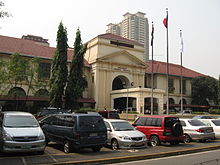Access to healthcare services in the Philippines is marked by significant inequities, particularly affecting poor communities. These disparities are reflected in both access to services,[1] health outcomes, and the effects of climate change which exacerbate the incidences of infectious diseases.[2] One major challenge is the varying financing for local government units, leading to differences in the benefits packages of insurance plans and difficulties in accessing public health services.[3] The decentralization of healthcare responsibilities from the federal government to local governments has, in some cases, increased local authority but has also made certain communities vulnerable to a lack of access to basic services.[4]

In response to the Millennium Development Goals' focus on maternal and child health, the Philippines began the National Demographic and Health Survey in 1968 to assess the effectiveness of public health programs in the country.[5]
- ^ Capanzana, Mario V.; Aguila, Divorah V. "119 - 129: Philippines Case Study: Government Policies on Nutrition Education". Karger.
- ^ Davila, Federico (December 13, 2019). "Human ecology and food discourses in a smallholder agricultural system in Leyte, The Philippines". Springerlink.
- ^ Silvestre, Maria Asuncion; Nuevo, Christian Edward; Ballesteros, Alfredo Jose C.; Bagas, Joy; Ulep, Valerie Gilbert (2023). "Identifying and Addressing the Determinants of Stunting in the First 1000 Days: Review of Nutrition Governance Strategies and Implementation of the Philippine Plan of Action for Nutrition (PPAN) 2017–2022". EconStor.
- ^ Viajar, Rowena V.; Dorado, Julieta B.; Rongavilla, Emily O.; Caraig, Georgina S.; Gulay, Joanne Jette S. (April 2022). "Monitoring the implementation of nutrition intervention at the local level". ScienceDirect.
- ^ "Philippines National Demographic and Health Survey 2013" (PDF).
© MMXXIII Rich X Search. We shall prevail. All rights reserved. Rich X Search
